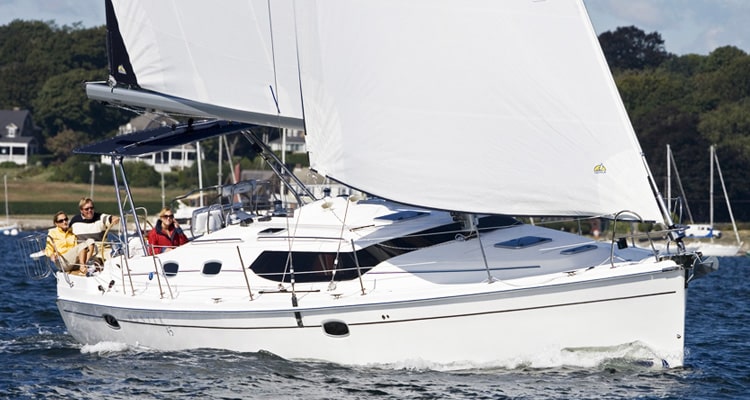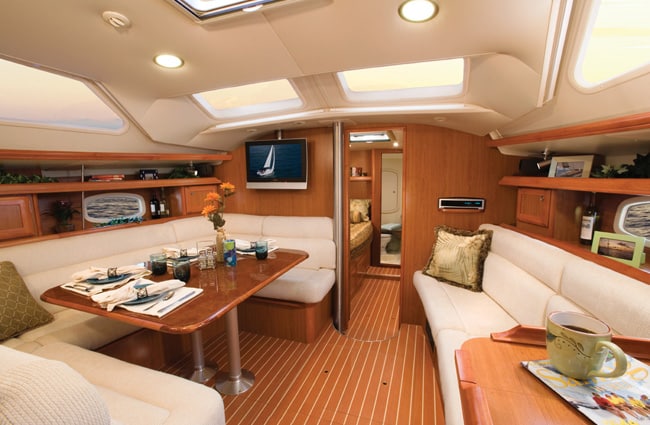
For a while, I thought we’d lost Glenn Henderson. Hunter Marine’s chief designer was on the speaker phone, delving into prismatic coefficients and the awful hull shapes encouraged by the International Offshore Rule in the 1970s. Gradually, eyes began glazing over even among the most avid sailing writers assembled to hear about the new Hunter 45 DS. But then Henderson wrapped it up quickly: “I finally realized it’s not about ultimate speed, for a cruising design, but how easy it is to get there.”
That about sums up the direction in which Henderson has been moving Hunter designs: better performance, easier to sail. The masts are low to keep the sails manageable (and to fit under bridges along the ICW), and the hulls are stable yet offer low resistance so they move along well.
“It’s not so much that they’re light-air boats,” said Henderson. “They’re boats with big rudders and small keels that need to foot, not pinch. They get there just as fast and riding easier. The hollow bows don’t pitch as much, traveling farther into each wave without bouncing up.”
We tested a shoal-draft prototype 45 DS off St. Augustine, Florida, in flat water and 6 to 8 knots of breeze. Sailing upwind at about 40-degrees apparent, the 45-foot, 23,000-pound cruiser always topped 5 knots and sometimes 6, despite its three-blade prop. Downwind, we set a cruising spinnaker and logged more than 7 knots, jibing through 90 to 100 degrees. It was a smooth and satisfying sail, aided by the responsive Lewmar steering, which has direct shaft linkages to the rudder quadrant.
Hunter has worked out a solid cockpit arrangement for the 45. Nothing unusual about twin wheels, but the centerline table has well-rounded edges and is ready to serve as a good brace in a seaway. The cockpit traveler arch has a 4:1 Harken traveler above a good-looking T-top bimini, and one part of the double-ended mainsheet leads down through a Spinlock rope clutch to an electric Lewmar winch that does double duty for the port jib sheet as well. The other part leads conventionally to another Lewmar sheet winch on the cabin top, so the sheet can be reached quickly from either location.
This is Hunter’s third deck-saloon model; the second was the 41 DS, a 2006 CW Boat of the Year winner for Best Value. (See “At Home with Speed,” June 2006, and www.cruising world.com/0606hunter41DS.) Overall, the saloon and galley are outstanding living spaces that are raised to take advantage of the visibility provided by six moderately large ports and a central overhead hatch, There’s good storage under the sole, as well.
To port, as you descend the companionway stairs, you’ll find a sole-to-ceiling post on the inboard end of the L-shaped galley that provides good support. Strong, grippable fiddles are at the ready, too; corner cuts in the well-designed galley make it easy to wipe the counter. The design is a good example of how Hunter sets up its boats for safe offshore use while still accommodating marina weekenders. Another example is the Force 10 propane stove, gimbaled for a seaway, alongside a microwave and a front-opening Waeco refrigerator.
To starboard lie the main head with shower and a front-facing nav station. Going forward, you’ll take a step down into the forward cabin, which has a Pullman-style double; it’s not huge, but it’s nearly 6 feet 6 inches long and easy to access. A head with shower is all the way in the bow.
The design’s only compromise belowdecks seemed to be in the aft cabin, which has a large island double but somewhat limited headroom. According to Steve Pettengill, Hunter’s offshore-sailing director, the design team is modifying the production version by extending the bridgedeck aft 8 inches, tightening up the soft headliners, and lowering the bunk mattress, all of which will increase space and improve access.
The cherry interior is bright and constructed with a film veneer on a marine-plywood laminate, which the company says is tough and hard to dent. The hull is constructed with a glass-and-balsa-core laminate above the waterline and solid glass below; in the bow, the laminate is reinforced with layers of Kevlar.

Hunter’s production team preassembles the interior as modular components, which are fit into a single, molded structural grid. Bulkheads are also glassed into the grid, and then the entire grid module is placed in the hull, where it’s both fiberglassed securely into the keel sump and glued elsewhere with an adhesive called Plexus; bulkheads are also glassed to the hull above the grid. Only then is the hull pulled from the mold and the deck mechanically fastened and glued to the hull’s external flange with 3M Marine 5200.
The boat has a newly developed all-iron keel (offered in both deep- and shoal-draft versions), although the boat we sailed carried an experimental hybrid keel made of cast iron with a lead bulb. Compared with the prototype keels, say Henderson, the iron production keel has equal stability because of the slight enlargement of its shoal-draft wings. Either way, the grid-and-keel package is sea-tested by Pettengill, whose job description includes running each new model hard aground 10 times or more to find any weak spots.
With the 45 DS, Henderson hasn’t changed the successful hull shape of the 44 DS he designed in 2003, but he’s moved the sail plan’s center of effort and the underbody’s center of lateral plane closer together to reduce weather helm. The keel is smaller and the rudder is bigger, so the boat is faster in light air and easier to steer.
I was impressed with the new design, especially the cockpit layout and the overall sailing ability of the boat. I’m ambivalent about the wraparound-windscreen look, but to my eye, its lower profile improves upon Hunter’s 2007 45 CC. Belowdecks, the 45 DS meets its design brief of being both capable offshore and accommodating for marina weekending.
John Burnham is the editor of Cruising World.








